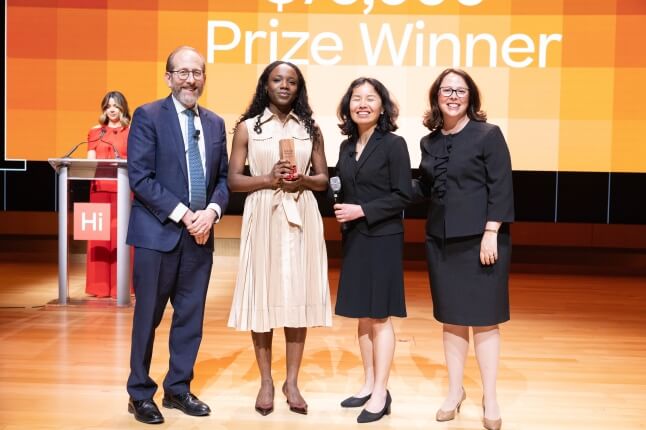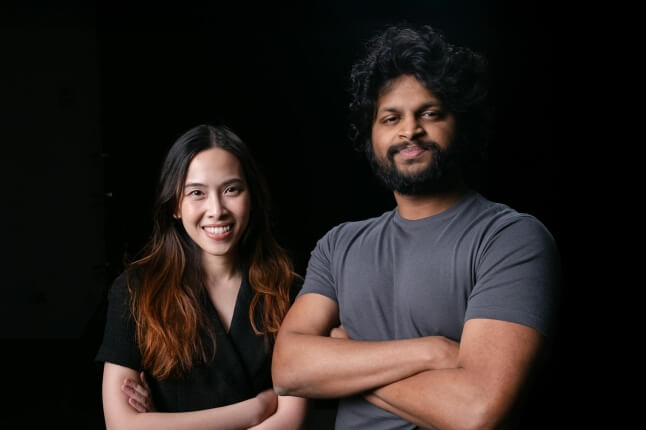News
Harvard seniors Ben Molin and Andreas Vandris launched the startup Jump Credit to provide a way to help low-income individuals take control of their credit. (Photo provided by Andreas Vandris.)
Millions of low-income Americans who have poor or no credit pay an average of $200,000 in additional interest and fees over their lifetimes, compared to borrowers with excellent credit. Many of these low-income individuals are shut off from the mainstream financial system and are forced to use expensive payday lenders and check cashers.
Jump Credit, a startup co-founded by Harvard John A. Paulson School of Engineering and Applied Sciences (SEAS) student entrepreneurs Andreas Vandris and Ben Molin, provides a way to help those individuals take control of their credit.
Their free software platform analyzes an individual’s credit report to generate an easy-to-read, customized action plan outlining the steps to a better credit score.
“Poor credit makes loans incredibly expensive or even completely inaccessible. Credit checks can also determine whether you get approved for housing or even whether you can get a job,” said Vandris, A.B. ’18, a statistics concentrator with a secondary in computer science. “If you have poor credit today, the odds are stacked against you. It becomes a downward spiral.”
Vandris saw the impacts of that downward spiral firsthand while providing credit advice to clients during an internship at the City of Boston’s Office of Financial Empowerment. He found that many clients with poor credit feel overwhelmed and confused about what comprises a credit score and the path to a better one.
A subprime credit score is below 660 on a scale of 300 to 850; factors like account payment history, amounts owed, length of credit history, types of credit used, and new credit are used to generate the score. For instance, missing a loan payment or applying for too many credit cards can lead to score reductions.
Vandris wanted to create a tool that could provide simple, actionable credit score advice. He shared the idea with Molin, who had experience interning for the City of Pittsburgh. Molin, A.B. ’18, an economics concentrator with a secondary in computer science, saw municipal governments and nonprofits as the ideal vehicle to reach low-income, economically vulnerable individuals.
Over the past several years, the paradigm in financial empowerment for lower-income people has shifted from emphasizing savings to emphasizing credit building, Molin said. Having access to credit allows families to weather emergencies and better manage their finances. In addition, it allows them to access safe financial products rather than resorting to unscrupulous payday lenders and check cashers.
As a result of this shift, many nonprofits and governments want to provide credit advice to their clients, but face obstacles in doing so, Molin said. Traditionally, getting a contract with a credit bureau and hiring or training staff can take several months and cost tens of thousands of dollars.
With Jump Credit, an organization can get started providing high-quality, personalized advice to its clients for free in just one hour.
“An employee of one of these organizations can simply spend five minutes with a client, pull his or her credit report for free, run it through our software, and give that individual an easy-to-follow plan to improve his or her credit score.” Molin said.
Vandris and Molin drew on many guidelines followed by credit counselors as they programmed the software to automatically analyze a report. They tested the platform with more than 100 users, going through each individual’s report by hand to ensure the software provided the best possible advice, then adjusted the algorithms accordingly.
Their biggest challenge was adapting the software to account for the many possible financial situations of clients, which can include student loans, credit cards, mortgages. and more, Molin said. The feedback they received in the SEAS course Engineering R&D (ES 95r), taught by Paul Bottino, Executive Director of Innovation Education, helped them develop a user-friendly web platform. Jump Credit received the Public Sector Innovation Award at the Harvard College i3 Innovation Challenge and was named runner-up in the Social Impact or Cultural Enterprise Category of the Harvard President's Innovation Challenge, earning $25,000 in prize money.
Now, Vandris and Molin are rolling out Jump Credit to municipalities and nonprofits across the country. Organizations can use the software to help their clients in one-on-one financial coaching sessions or group educational workshops.
In addition, the co-founders envision Jump Credit being used at tax time as part of the IRS-sponsored Volunteer Income Tax Assistance Program (VITA), which provides free, in-person tax preparation for 3.3 million people each year at 9,000 locations nationwide.
Since many individuals who visit VITA sites receive tax refunds, it is the ideal time to advise them on making the most of their refunds to improve their credit, Vandris said. For some, the refund can represent up to 20 percent of their annual income.
Molin and Vandris visited a local VITA site, which is run by Harvard Law School students at the Cambridge Public Library, to showcase how Jump Credit could be effectively used in the context of tax preparation. While taxpayers are waiting to get their taxes prepared, a staff member can provide them with personalized credit advice in just a few minutes.
So far, Vandris and Molin have partnered with non-profits and municipalities in five states. Energized by the fast pace of that rollout, they hope to continue working with organizations to reach tens of thousands of people next year.
“We want to empower people to take control of their financial situation and build a brighter future for themselves,” Vandris said. “Everyone can benefit from better credit.”
Topics: Entrepreneurship
Cutting-edge science delivered direct to your inbox.
Join the Harvard SEAS mailing list.
Press Contact
Adam Zewe | 617-496-5878 | azewe@seas.harvard.edu



